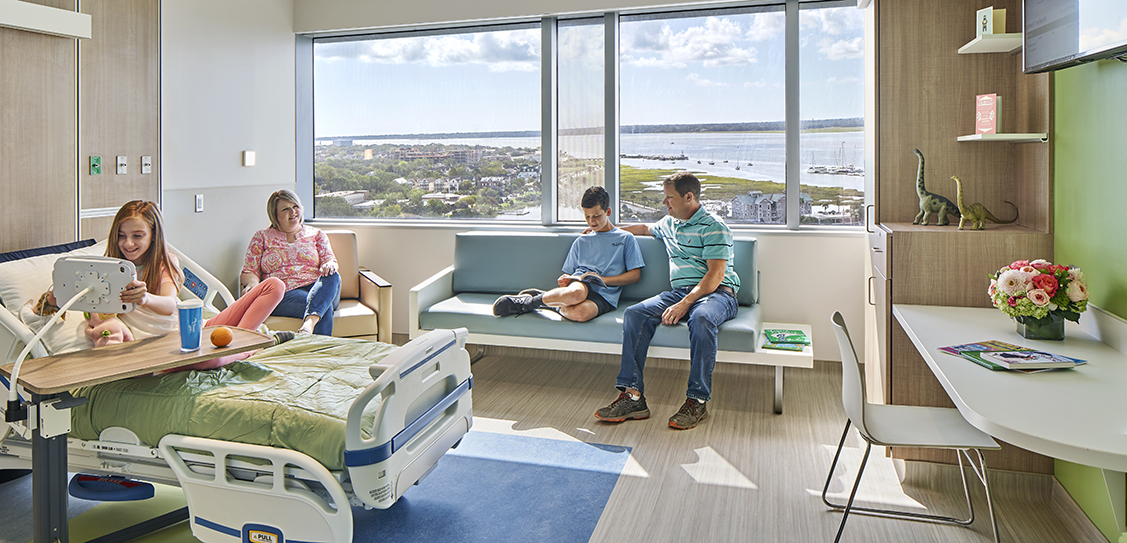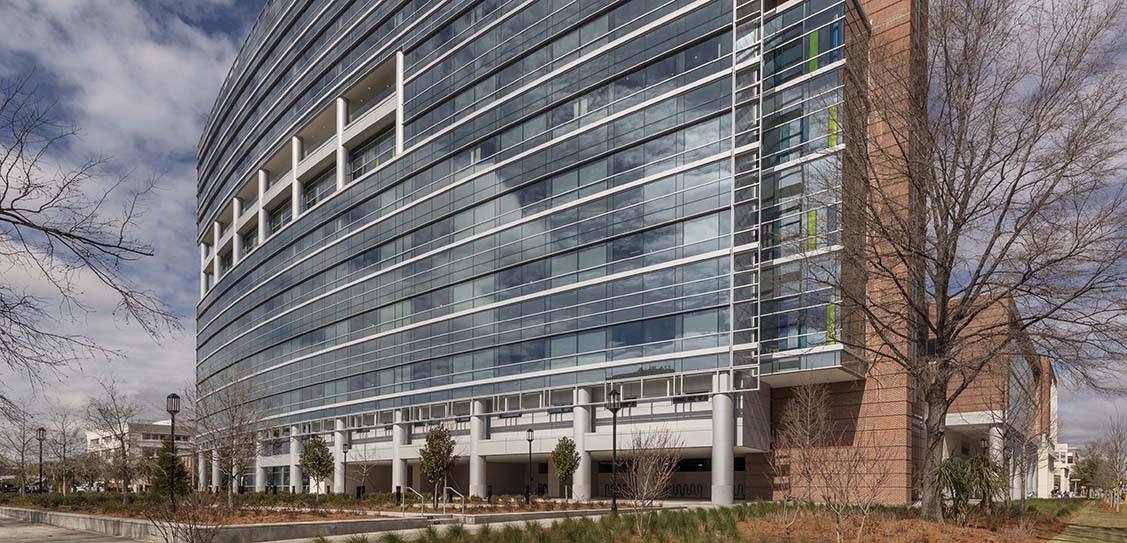The new Medical University of South Carolina Shawn Jenkins Children’s Hospital and Pearl Tourville Women’s Pavilion (MUSC), aims to set a new precedent for inclusive healthcare design. The landmark facility rethinks traditional norms with a design that responds to the complex needs of both patients, staff, and the local community.
McMillan Pazdan Smith Architecture, the new 625,000 sq ft facility provides integrated medical care for children, as well as obstetrical services for women. Located in Charleston, South Carolina, MUSC opened its doors to patients early this year after a collaborative process that included clinical and administrative leadership, Child Life, the MUSC Patient Family Advisory Council and Youth Council.
From the outside-in, the new facility is designed to be both inclusive and joyful, anchored by a welcoming south façade that incorporates an iconic glass “sail” feature, oriented to the waters of Charleston Bay where the Ashley and Cooper Rivers merge.
The two storey Main Lobby was inspired by Courtyard Garden in historic Charleston. Cypress paneling was created from recovered pilings that held up the site's previous hospital, the McClennan Banks Building.
Overlooking the Main Lobby, it was critical for the design team to create a space of calm and reduce environmental stressors throughout the interior.
The design team harnessed feedback from parents with children on the autism spectrum to deliver a full-sensory design response.
Special care and consideration was paid to remove potential triggers that could create an overwhelming environment. Instead, the design prioritises calming the senses with a lack of visual clutter, carefully thought out travel paths, scale, and lighting controls for patients to adjust as needed. Acoustic considerations were also made to the interior, including removal of automatic flushers and hand dryers in bathrooms.
Designers worked with MUSC’s Child Life programme to create a sensory room dedicated to patients on the spectrum. In addition, a roof garden/play area provides a place for children and families to connect with nature and find a place of respite. The Child Life Play Atrium on the 7th Floor showcases a custom mural by Sisal Creative, a team of Charleston artists, features themes of the Lowcountry consisting of small objects for children to "find" like an "I-spy" game.
The building's architecture, interiors, and surrounding landscape are integrated and rooted in MUSC's theme 'Stories of the Lowcountry.' The exterior features plants from the Charleston area and the paths in the roof garden are inspired by the sinuous paths of the roof garden informed by the marshes of the Lowcountry of the area. The building’s glass façade was intended to filter through the Lowcountry light, creating illuminated patterns on the brightly coloured interiors. What's more, the building’s form and function were also purposefully articulated to maximise views of the city and the waterfront below.
Moving indoors, neutral colour palettes inspired by sweetgrass baskets and traditional haint blue hues in the elevator lobby provide a playful nod to Charleston's history. Multicolour room fronts play homage to the city’s celebrated Rainbow Row. Within the hospital rooms, the use of textures and tones pays tribute to Charleston’s beach houses, creating a feeling of respite and recovery for children.
While Courtyard Garden lounges accommodate larger groups, these respite areas within the unit are intended to provide quiet respite for individuals or smaller groups.
The design team worked with local artists, SDCO Partners, to create graphic walls. Each floor features a graphic representation and distinct colour identifying the theme of that floor, they enhance a sense of place and help wayfinding.
Visitors are immediately greeted by an installation by local photographer John Duckworth, who captured the essence of the South Carolina marsh, reproduced in a film layer between glass. In the chapel, meanwhile, a glass wall created by Robert "Bob" Hines, was created using fractal geometries in wood and glass for an abstracted interpretation of Angel Oak, a four to five centuries old southern live oak on St. Johns Island, near Charleston.
The design team also set up an art location plan that will enable MUSC to add artwork in the future, pending committee approval.
A noted local art photographer, John Duckworth, was commissioned to capture the essence of the marsh. His work was reproduced in a film layer between glass, on display to welcome visitors to the hospital.
Located in the Meditation Room, this Bob Hines glass, wood framed fractal patterned interpretation of Angel Oak, a majestic local Southern Live Oak that is estimated to be at least four centuries old.
Patient bedrooms were inspired by local beach houses, with wood floor, area rugs, simplicity of furnishings. These are designed to encourage children to decorate their own, with writable paint surfaces, shelves, desks.
The design purposefully and strategically connects the interiors with the outdoors as caregiver wellbeing is important, and making access to fresh air and daylight near patient units possible. Large porches accented by columns and biophilia are signature elements providing shaded outdoor living areas. Meanwhile, courtyard gardens with arched openings and hedges inform lobby and waiting areas.
The Staff Respite Terrace offers caregivers an area for solitude accessed via back of house offstage access on the eighth floor.
The family dining terrace near family amenities, cafeteria, conference rooms, meditation chapel, child life play roof deck and atrium space, adds an outdoor element on the seventh floor.
A whimsical play on the Courtyard Garden arches creates niches for play areas in the waiting lounge area.
Situated on former marshland, the facility prioritises resiliency in its design response with all patient care areas placed above designated flood elevation.
Exteriors were strategically selected to meet hurricane-force winds and resist the impact of flying debris. The ground floor was equipped with flood-proof panels and emergency generators out of reach of floodwaters among many other design features for other potential natural disaster events.
The building is set back from the street, creating an "urban green space" which is a gesture to Charleston’s green civic gardens. A low seat wall around three sides defines this space and elevates the planting above low-level floods to improve the resiliency of the landscape with native plants selected to aid in the rising tide flows.



